

Consolarium blog
Actually, that should be “If they build, they will come….”
Build what though? Enter Arduino.
Arduino is an open-source electronics prototyping platform based on flexible, easy-to-use hardware and software. It’s intended for artists, designers, hobbyists, and anyone interested in creating interactive objects or environments.
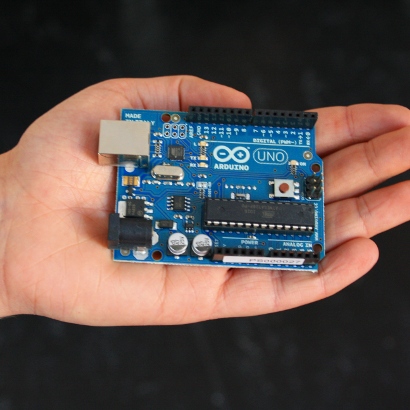
I have been playing around with arduino for a while now and on friday 11th March I had the opportunity to attend an arduino work shop for schools, thanks to Steve Bunce at Vital.
What strikes me about Arduino is the opportunities if offers to link up subjects in the context of CfE. Not only can our learners be offered the opportunity to learn to program, but can get some physical hands on time by building a device, learning about resistors, actuators, transistors, motors and a number of other electrical and mechanical devices. There are even soft Arduino components (such as the Lilypad) that allow learners to build electronic clothing. A quick search on Youtube or Vimeo for Arduino will give you a flavour of the types of projects that can be built.
Make Magazine is a great resource to get some Arduino inspiration and starter tips.
The Consolarium have bought some Arduino starter kits and are working with Braeview Academy in Dundee to see how effective it can be within the curriculum.
As part of the game design work the Consolarium have been carrying out, we often visit subject leaders meetings and are invited to ISIS days to do some CPD with staff. Recently, I visited a group of computing teachers in Ayr to take them through possible uses of BYOB in their Computing courses as a follow on / extension to Scratch. The session was well received and the teachers seemed quite inspired to take BYOB forward in their schools. However, it was perhaps the use of external devices with Scratch or BYOB that really caught their eye.
Scratch 1.4 and BYOB have the ability to interact with external hardware such as Picoboards through the sensor options. However, it’s not just Picoboards that can interact with Scratch.
Lego Wedo
The Lego Wedo sensors and motors can also be used with the sensors. In particular, the LEGO® WeDo™ Robotics Motion Sensor and the LEGO® WeDo™ Robotics Tilt Sensor can be used to detect the outside world. Note - a Lego Power Functions Extension Wire and Lego USB hub are also required.
What’s really interesting about this in terms of the gaming world is that there is potential for pupils to use these sensors to build their own controller for a game - perhaps linking up with Design and Technology / 3D Modelling courses to design and build their own controllers that could house the lego sensors. I demonstrated about this at a Teachmeet last year.
Kinect
Then we come to the Kinect. Yes, the Microsoft Kinect Motion Sensor can be used with Scratch! Stephen Howell took some time to get the Kinect sensor to interact and work with Scratch as an input device. Watch his demo below:
Scratch and Kinect from Stephen Howell on Vimeo.
Find out how to do this on Stephen’s blog. I have used Stephen’s program and was really engaged and excited by it. I think it would make Game Design with Scratch even more attractive and challenging for our learners.
Console Controllers
 If our learners are creating games with Scratch, why not get them to play/control their games with their own console controllers? There are many controller mapping programs available for PC and Mac that will allow users to map their keyboard and mouse presses to a controller. So, if our pupils create a game that uses the arrow keys to move, why not map the arrow keys to the controller allowing the player to use hardware that they are familiar with, that sits within their own cultural domain, to play the game?
If our learners are creating games with Scratch, why not get them to play/control their games with their own console controllers? There are many controller mapping programs available for PC and Mac that will allow users to map their keyboard and mouse presses to a controller. So, if our pupils create a game that uses the arrow keys to move, why not map the arrow keys to the controller allowing the player to use hardware that they are familiar with, that sits within their own cultural domain, to play the game?
Microphone
Finally, what about other modes of control? The sensor blocks in Scratch have a loudness command. Could we challenge our learners to create a game that responds to noise levels? For example, consider this:
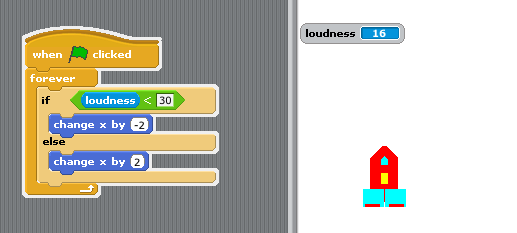
Using the loudness sensor we can control the left / right movement of the rocket.
Overall….
While Scratch and BYOB are not specifically deigned to create games, they are often used for this task as they offer a friendly, easy to use environment. However, by using additional gaming hardware, we can create a learning environment that should hopefully resonate with our pupils and encourage them to engage with the game design process further.
MoreMIT’s Scratch program has become a firm favourite in Primary and Secondary schools all over Scotland. It is a great tool to create a variety of interactive media resources such as games, art, simulations and stories. You are only limited by your imagination!
However, as more and more pupils are experiencing Scratch in their Primary classes or through their own curiosity at home, many secondary subjects that currently use Scratch (usually Computing departments) may be wondering how to build on these skills gained pre-secondary school.
One opportunity for extending the learning opportunities with Scratch lies with the BYOB mod of Scratch. BYOB has all the features of the regular Scratch program, but has a couple of very exciting extras. Including:
For the purpose of this post, I would like to demonstrate points 4 and 5 - the ability to pass information between 2 or more computers. Lets look at an example:
The BYOB software, used in this way, provides us with a tool for learners that immediately promotes, and indeed requires, cooperative working and discussion. Charlie and myself have been demoing this implementation with Computing teachers at CPD events over Scotland in the last month or so. We have been delighted to see the discussion and cooperative working that needs to take place in order for learners to create what is,essentially, a multiplayer networked game.
Using the technique above of hosting a mesh and reading in variable data using the sensing option, user can quite quickly create a 2 player tennis style game as illustrated below.
These videos are a little rough around the edges, but I intend to re-do them as a set of tutorial videos to be hosted within our game design Glow group. This tutorial set will take users through the steps to make the tennis game.
Please get in touch if you have already been using BYOB with your classes and share your experience with us.
MoreAt the Consolarium, we are always eager to look for new games to add to our Game Based Learning projects. In mid November 2010, Electronic Arts will release EA Create.
Create Game Info
In Create, use your creativity and imagination to unlock a world of play!
Create tracks your creativity and rewards you for it. The more you create, the more you unlock rewards and exciting challenges to play, opening a world of fun as you go.
Let your imagination run wild, as you create cool environments with easy-to-use tools, including animating objects, textures, and designs that bring your scene to life!
It’s a limitless experience of creative expression paired with exciting and even wacky challenges that have you thinking on your feet to come up with creative solutions.
EA Create seems to have more than a couple of similarities to Little Big Planet for the PS3, but with one big difference - Create will be available for Wii, Xbox, PS3, Mac and PC. With an internet connection, users on any platform will be able to upload their creations and download any other creation and remix it - regardless of what platform they are using, with the exception of the Wii.
This particular game seems to offer a number of opportunities for Game Based Learning projects and indeed may be a great tool to close the gap between game players, game based learners and game creators. A few reasons we are hopeful for this particular game include:
I was thinking that schools could use this game to engage with probelm solving and creativity. Then, set groups of pupils a challange to build a crazy contrapation like a Rube Goldberg machine, just like they can do in create - solve a simple problem by creating a complex solution. Have a look at OK Go’s video for their song ‘This To Shall Pass’ to see such a machine in operation.
A project like this could be a great way to build teamwork, cooperation, environment/recycling, not to mention inter disciplinary links. Look out for an update in the new year once we’ve had a chance to get creating ourselves!
More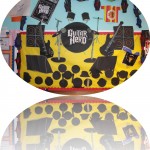
I had a most enjoyable and very interesting day touring 4 schools in Falkirk who are all undertaking a transition project with Guitar Hero. The teacher leading this within Falkirk, Stacey Collier-West, had planned a full timetable and we set off from Maddiston Primary where she is based and travelled to see Avonbridge Primary, Whitecross Primary and Shieldhill Primary as well as stopping off back at Maddiston to see the pupils working on this topic.
The first thing that was absolutely apparent from all the schools I visited was the engagement shown from all teachers and pupils involved, but what I found more interesting was the range of approaches across the schools but all within the same context. Every teacher involved had been part of the inital planning and were in regular contact with each other but each one was very firmly focussed on what the children in their schools needed. Seeing this so clearly reinforced with me the fact that this fact should remain at the forefront of the mind of any school undertaking a GBL topic.
Have a look and a listen to some of the work we saw on our quick journey around Falkirk starting with writing in Whitecross Primary. Click on Mr Horne below to hear him chat about writing in his class.
In the video clip below we can see how the classes are building towards their concert. We can see them making stop frame animations with a simple digital camera and windows moviemaker software, which is a free part of most, if not all, winows pc s. I love seeing everyday things used in an imaginative way like this, we then have a chat with a couple of groups of children who talk about what kinds of learning they are undertaking in order to get themselves ready for the show including writing lyrics, choreography and animation. Next we meet another band getting their moves ready for the concert and chatting about how they have undertaken the work and finally we meet two of the teachers who have been running the theme in their class and hear them discuss the impact on the children.
As mentioned previously, all the schools were working toward a final showcase event where they would perform the songs they had written, show their choreographed moves and have their animations playing in the background. As you could probably see from the slideshow above all the bands had also designed their own tshirts which they then sold and each school made a cd of the tracks they had produce and offered them for sale at the concert also. Brian Clark, Ollie Bray and myself got ourselves invited to the final concert and we had a wonderful time watching as all the children performed in front of their peers, parents and friends. Every child successful, confident, responsible and effective. Watch highlights of the show below.
MoreFor a number of months I have been doing some work in and around South Lanarkshire authority, first of all with Aubrey Taylor from the Advisory Service running staff development and latterly with the support of Andrea Reid QIO in a number of primary and  nursery schools. It’s really great seeing so many forward thinking folks in education in such close proximity to each other. A good number of schools are running their own GBL topics with and really staring to get great results from their work.
nursery schools. It’s really great seeing so many forward thinking folks in education in such close proximity to each other. A good number of schools are running their own GBL topics with and really staring to get great results from their work.
In particular I enjoyed visiting Cathkin Community Nursery which , with the support of Andrea Reid, has been undertaking a topic on pets which has included input from a special pet called “Eyepet” which comes as software on the PS3. Check the video below for a wee flavour of the kinds of things he can do..
The steps shown in the video are only a small part of how the nursery went about planning and implementing a project with Eyepet, but a case study exemplification will be produced and shared over the next couple of months.
I had never seen a GBL topic wholly undertaken in the nursery setting so I was intrigued to find out how they had gone about it. Liz Mercer the Head of Nursery was delighted with the way the project worked and how well it involved the children and their families.
“We are thoroughly enjoying our eyepets. They are part of our family now and the children have taken to them so well. Each group had adopted an eyepet, where they nurture and care for him/her. Some children have also created their own eyepet using a variety of materials. They are fab and on display in the room where eyepet lives and breathes.”
Cathkin Community Nursery then took the expertise they had gained from running Eyepet as part of their project and held an open doors event where the Early Years workers shared their experience of using Eyepet and how it tied to the curriculum with colleagues from South Lanarkshire. There were also a number of other brilliant presentations on involving parents and involving children in the planning process and digital learning books. The evaluations from this event were wholly positive and it was great to see CPD opportunities like this being provided by practitioners for practitioners. Liz and the team are real advocates of CfE, and you can see from the slideshow below how that looks in practice when undertaking the Eyepet project.
You may also be interested in reading the thoughts of HMIE about this nursery. Their report was published today and all areas of their work were graded as Excellent and HMIE thought their work with Eyepet was wonderful.
“Staff provide a very well-balanced curriculum firmly based on play, active learning and enjoyment. High quality staff interaction, a stimulating environment and very well planned use of resources support children’s progress most effectively”
We currently have a number of Eyepets out on loan across Scotland at the moment, some as transition projects and some as literacy focus work and the pictures below are of some of the reactions of children watching their Eyepet hatch and some of the work that has come out of looking after their Eyepet.
As a follow on to that I attended a couple of parent workshops run by Colin Venters from South Lanarkshire’s Home School Partnership, encouraging parents to see the potential of their child’s use of gaming consoles as a positive chance for meaningful interaction between themselves and their child. Hear below what Colin and some of the parents who visited had to say about these sessions.
MoreLast week, Charlie posted a summary of our 2 day Kodu training session with the Girvan Academy cluster schools. We had 2 teachers from the secondary school, 12 from primary schoosl and 1 from the local authority. After receiving some feedback on the event from the staff involved, I thought I’d share what we learned from what we hope will be the first of many Kodu training events.
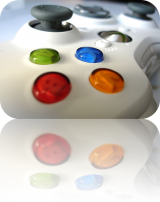 We decided to start the training getting the teachers to use the terrain building tools in order to familiarise themselves with the Kodu interface and the controller. Trying to stay topical, we decided to model a volcano. However, as Charlie previously mentioned, one of the key difficulties we found, was that a number of staff had never held an Xbox controller or played a 3d computer game.
We decided to start the training getting the teachers to use the terrain building tools in order to familiarise themselves with the Kodu interface and the controller. Trying to stay topical, we decided to model a volcano. However, as Charlie previously mentioned, one of the key difficulties we found, was that a number of staff had never held an Xbox controller or played a 3d computer game.
As it turned out, many of the teachers involved did find the 3D world difficult to navigate/play in. Just too much movement on the screen for them to deal with. While they all agreed that this wouldn’t be an issue for pupils as they are’ 3D native’, we needed to address this. So, Charlie and I changed track slightly and decided to focus on static world games.
By setting the camera position to fixed, we took the teachers through building games based on the classics such as Frogger and Space Invaders. This technique allowed the teachers to build worlds without that initial disorientation they experienced with the camera set to free mode. This allowed the teachers to focus more on game functionality and scripting.

It seemed obvious to then move to the Fixed Offset camera mode where the camera angle tracks the main game character; this allowed the teachers to engage a little more on the terrain building aspect of Kodu. During this task we set about making side scrolling games in the classic Mario / Sonic style.
It should be at this point we moved to the full Free mode option and get the teachers to create fuller 3D worlds and utilise the scripting techniques they gained during the Space Invader/Mario-esque games.
As for scripting, using creatables and making paths – all of which Charlie and I thought might be too much for inexperienced teachers, turned out to be one of the most rewarding aspects of the course. With the free motion 3D issue dealt with, the attendees got stuck into the mechanics of the games they were making.
That being said, there were of course a number of teachers who were familiar with the 3D free scrolling games of the Xbox generation. Their experience in this genre of game allowed them to carry out most of the tasks with little or no difficulty and illustrated the need for strategies to deal with such a diverse set of learners such as this. One welcome suggestion was that we should have training days especially for primary school teachers and secondary school teachers (in particular secondary Computing teachers)
So, what have we learned from our initial 2 training days when dealing with non experienced gamers?
Both Charlie and I will be out to visit and support the implementation on Kodu in this cluster and continue to feedback to you here and within GLOW, with a particular focus of Curriculum for Excellence. Within GLOW we will encourage the teachers involved will contribute to discussions, lesson ideas and resources over the next few months for all of us to use.
On the whole, it was a very rewarding couple of days, and those that attended gave really useful feedback in relation to their pupils learning experiences and curriculum for excellence, as well as how we can refine this training process. I will leave you with a few of thoughts from some of the teachers that attended our course.
I would like to give Kudo a go as soon as possible, it would certainly answer the outcome of making a game, also I can see it cross curricular potential. I found the course worthwhile and it opened up my brain to a different type of learning. The kids will love it.
I’d really like to develop the use of Kodu and link it with literacy as a school project.
Kodu is a wonderful tool to use in class and pupils would be highly motivated to learn how to make games. Training days were useful to show teachers what is available and how it can be used with pupils.
I think Kodu is a great tool and well worth doing with the P7s. Whether I could call myself capable to teach it after only two days is debatable. Possibly access to a helpdesk via e-mail or some such would be good as I fear a lot of problems may crop up of which I won’t know the answers.
I did learn a great deal from the two days as well as it being inspirational. I would also like to thank the presenters for their patience and hard work. They made it fun to learn. I will definitely use Kodu in Dailly Primary
More
<cue Murray Walker voice>
………….and there goes Mario!
………………and there goes Luigi!
F1 season is well underway and all over Scotland schools are taking up the SLF10 Mario Challenge.
Would you like to race head to head, in front of a live audience and win the title of
SLF10 MarioKarter Champion ?
This year at SLF10 there will be a Mario Kart Grand Prix for Primary and Secondary pupils. In order to qualify you must be in the top 4 verified time trial times.
Teachers must submit a photo of a pupil’s verified Time Trial time. These times will be logged on a leader board held on the Consolarium Glow Group and blog so you can track your position against the whole of Scotland.
At the moment these leaderboards are empty (apart from my rubbish time!) - submit your time now!
The four fastest primary pupils and four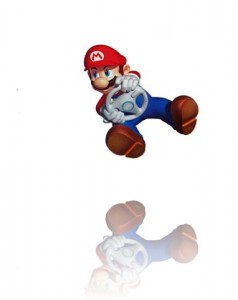 fastest secondary pupils will be invited, with school representatives, to compete in a live race final at SLF10. In order to submit a qualifying time you must run your time trial according to the criteria below.
fastest secondary pupils will be invited, with school representatives, to compete in a live race final at SLF10. In order to submit a qualifying time you must run your time trial according to the criteria below.
| The character must be | MARIO |
| The circuit must be | MARIO CIRCUIT |
| The Kart must be | STANDARD KART |
A picture of the complete time trial showing character, kart and time should be forwarded to[email protected]
The four fastest pupils from each sector will then race head to head in the
50cc Mushroom Cup Grand Prix
in front of a live audience at SLF10.
The driver with the most amount of points at the end of the Grand Prix will be the winner and crowned Mario Kart Champion SLF10 and win a Wii and copy of Mario Kart for their school.
Check out the glow group where schools involved will be posting plans, pictures and joining discussions about the game and the work they are undertaking within their class using Mario Kart as a contextual hub or as a subject specific theme.
The closing date for verified Time Trial times is September 3rd 2010. Qualifiers will be contacted after this date
More
The latest edition of the Consolarium podcast is now available. You can subscribe to the podcast from itunes via this link or listen to it via the embedded player.
Super samba inspired learning in schools!
This edition of the Consolarium podcast is solely dedicated to a project that came to an end just before Christmas 2009. Meldrum PS and Slains PS in Aberdeesnhire had been working with the game Samba de Amigo for the Nintendo Wii. When this game first came out the team at the Consolarium thought that this would have great potential in schools and so it was duly purchased. Here’s what it looks like:
OK, I think that after that clip you may be asking, “How on earth can a game that requires the player to shake out samba rhythms help children learn?” Well it most certainly has. What has been going on?
Samba de Amigo inspires ‘relevant and engaging learning’
The methodology that the Consolarium invariably employs in our approach to game based learning involves the computer game being used as the central ‘contextual hub’ about which learning can be situated. We have used this approach with many of our previous projects and it has proved to be a successful methodology. The teachers involved in this project worked together to create a collaborative story that focused on a rags to riches tale about a favela dwelling samba musician who made it to the big time. Accompanying this came the story of a plane, that was carrying the newly created Samba music superstar, crashing in the Amazon jungle and the associated learning about that. Here is some of the children’s work. Here is a news report of that event:
Some people may still be of the opinion that the idea of game based learning is something that does not sit with what school should be about but we would argue that game based learning, if used appropriately, can excite, challenge and create relevant and appealing contexts for learners. Just look at how writing has been developed here”
If you take the time to listen to the podcast about the Samba de Amigo project then you’ll here us talking to a pupil about his experience. If we could have written a script for a pupil to read out about the benefits of game based learning then what he said (without coaching or prompting we may add) would have been what we would have said. He talks about his learning connecting up, about it being exciting and active and how he will rmember this project. Great stuff from him. Here is a brief clip of some boys actively involved in the project and warming up for their Samba music creation lesson.
Hopefully the podcast and this brief blogpost will give you a flavour of just how good this GBL project was. A fuller account of what was done and how this GBL context impacted on learning will be released in the near future. In the meantime can we just say thanks to all at Meldrum PS and Slains PS for working with us on this project.
MoreCalling all Jenson Button and Lewis Hamiltons of the future.
Would you like to race head to head, in front of a live audience and win the title of
SLF10 MarioKarter Champion ?
This year at SLF10 there will be a Mario Kart Grand Prix for Primary and Secondary pupils. In order to qualify you must be in the top 4 verified time trial times.
Teachers must submit a photo of a pupil’s verified Time Trial time. These times will be logged on a leader board held on the Consolarium Glow Group and blog so you can track your position against the whole of Scotland. The four fastest primary pupils and four fastest secondary pupils will be invited, with school representatives, to compete in a live race final at SLF10. In order to submit a qualifying time you must run your time trial according to the criteria below.
fastest secondary pupils will be invited, with school representatives, to compete in a live race final at SLF10. In order to submit a qualifying time you must run your time trial according to the criteria below.
| The character must be | MARIO |
| The circuit must be | MARIO CIRCUIT |
| The Kart must be | STANDARD KART |
A picture of the complete time trial showing character, kart and time should be forwarded to [email protected]
The four fastest pupils from each sector will then race head to head in the
50cc Mushroom Cup Grand Prix
in front of a live audience at SLF10.
The driver with the most amount of points at the end of the Grand Prix will be the winner and crowned Mario Kart Champion SLF10 and win a Wii and copy of Mario Kart for their school.
The closing date for verified Time Trial times is September 3rd 2010. Qualifiers will be contacted after this date.
Have you thought about using MarioKart in your class as a contextual hub or topic? Check out the Consolarium Glow Group for ideas on how you might do this. You might also want to think about how you might use MarioKart in subject specific lessons also. Share your thoughts on the Discussion Board at the Wii, Mario Kart section of the Consolarium Glow Group.
We also have a small number of MarioKart kits (console, software and controllers) available on loan until SLF10. If you are interested in receiving one on loan send us a summary of how you would use it and what you feel the impact would be upon your pupils. Our team will get together and examine all bids and decide upon the lucky applicants. Please send bids to [email protected] and ensure all bids are with us by Monday March 8th.
More
Find us on